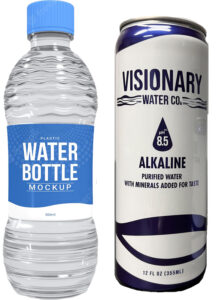
Why Aluminum Cans?
Recycling plastic is more complex, leads to degradation, and has lower reuse rates than aluminum – so the metal has been heralded as a greener alternative. Cans have an average of 68% recycled content compared to just 3% for plastic in the United States.
Environmental Protection Agency data show:
- Plastic may dissolve harmful chemicals in its contents. Aluminum cans do not, which makes Aluminum cans safer to drink from.
- Keeps drinks cold longer (as long as they aren’t left in the sun)
- Aluminum is infinitely recyclable
- They contribute less to environmental problems like acid rain and oxygen-free zones in the ocean.
- Nearly 75% of all aluminum ever produced is still in use today (According to the Aluminum Association)
- Only 9% of all plastics ever made have been recycled. 6.3 billion of the 8.3 billion metric tons of all plastic ever made has become waste (study by Science Advances, 2017). Where is the waste going?
- Aluminum beverage cans contain far more recycled content than glass or plastic and save huge amounts of energy in transportation and refrigeration (according to the Aluminum Association)
- Aluminum contains 73% recycled content on average. Plastic Bottles contain only 3-10%. Aluminum is up to 20x the recycled content of plastic bottles (Aluminum Association)
- Recycling Aluminum saves 95% of the energy needed to make new aluminum (Aluminum Association)
- “Across all scenarios studied, aluminum has lower associated use-phase emissions than comparable glass or plastic containers” – Marian Van Pelt, VP at ICF International on how combined greenhouse gas emissions associated with the transportation and refrigeration of beverages in aluminum cans are lower.
